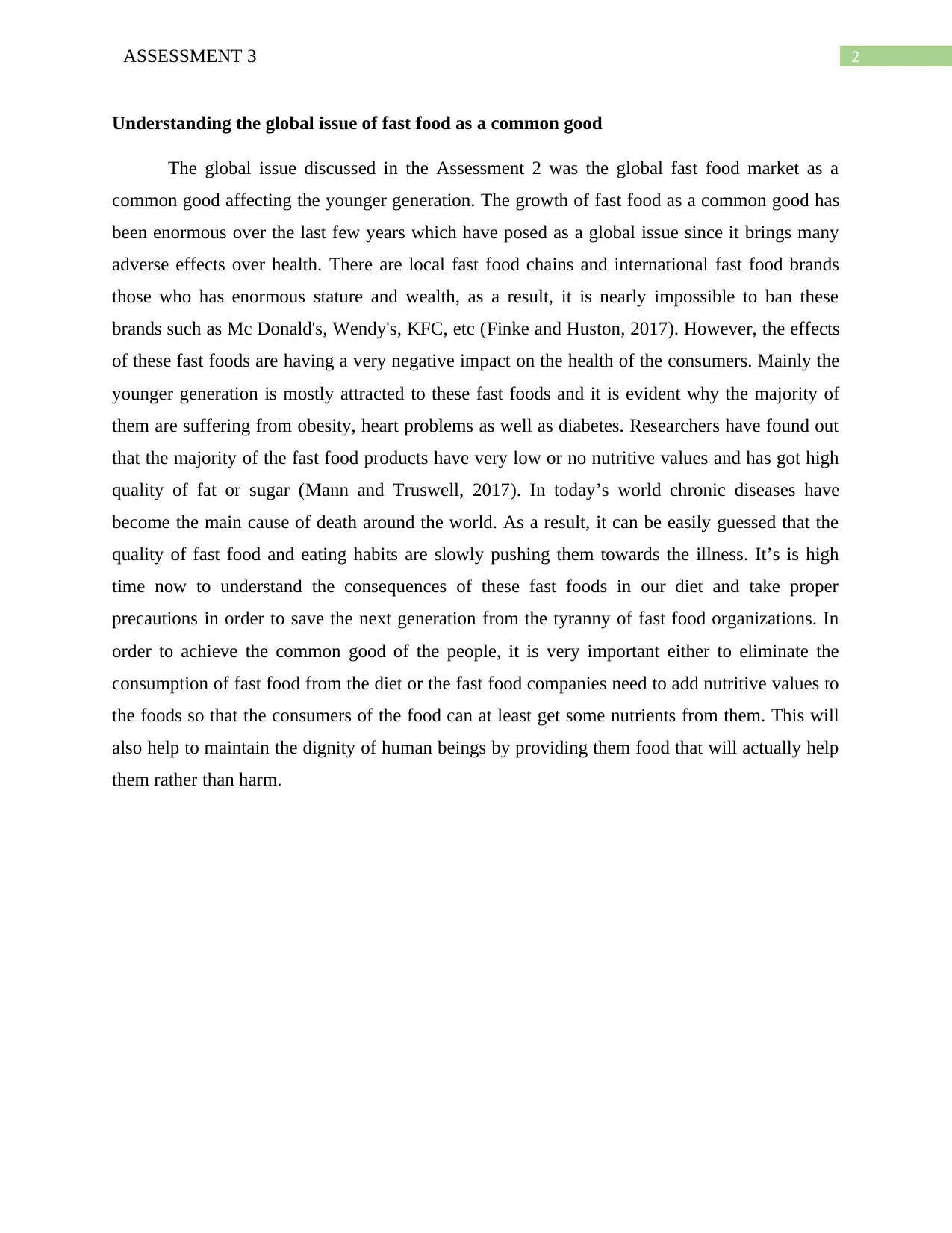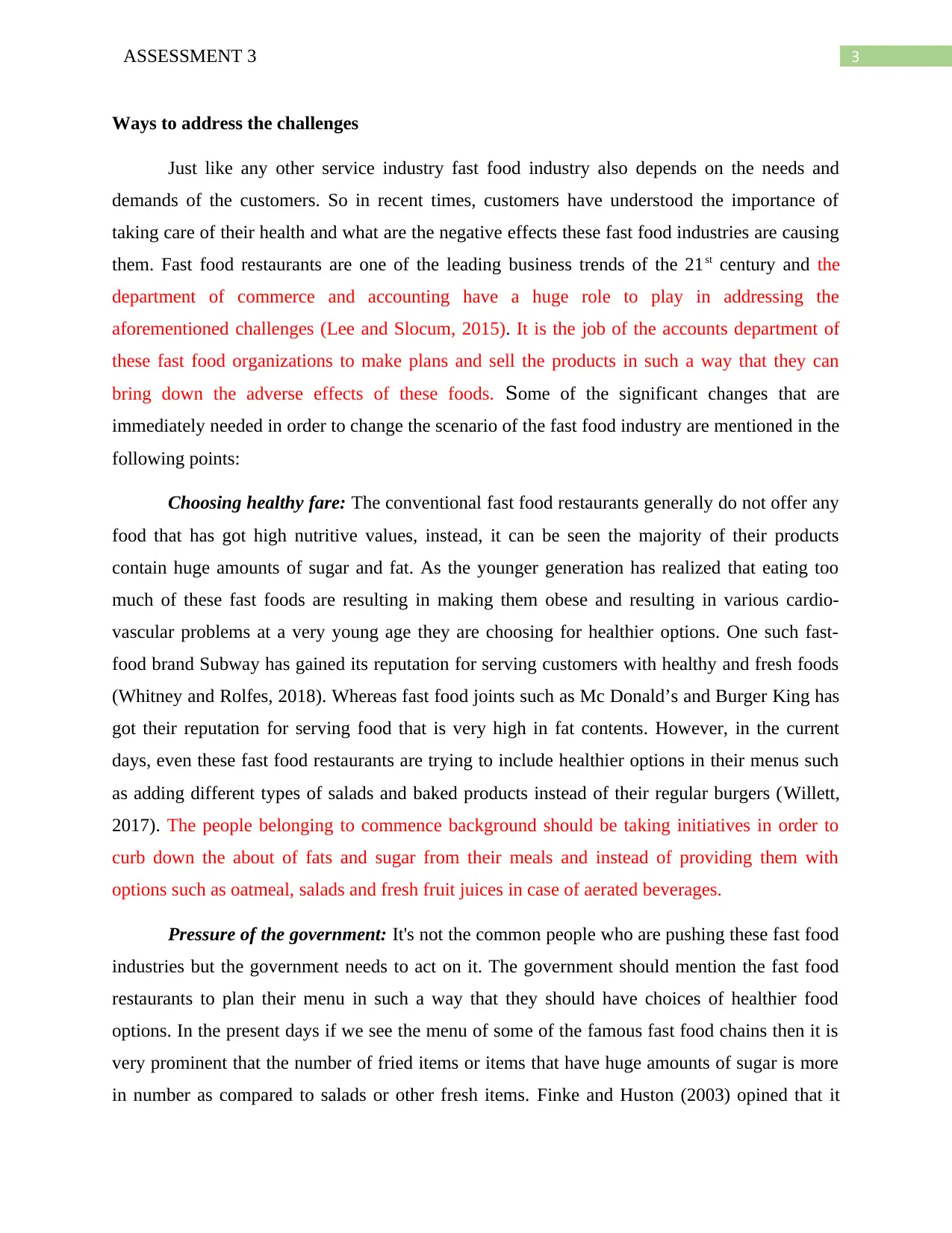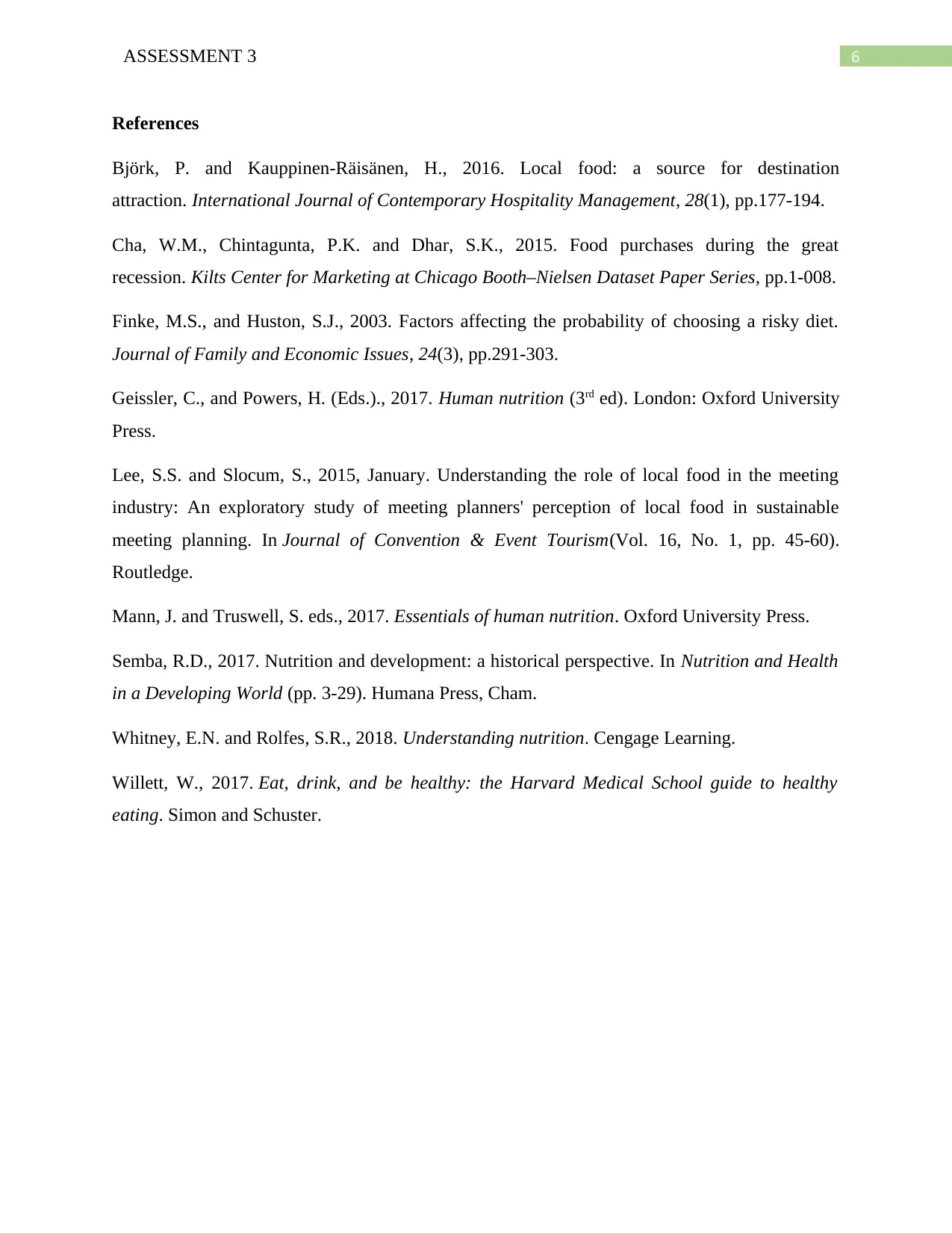Addressing Fast Food Challenges: A Focus on Health and Nutrition
VerifiedAdded on 2023/01/23
|6
|1741
|62
Report
AI Summary
This report addresses the global issue of the fast food market's impact on the younger generation's health, highlighting the rise of fast food as a common good with adverse effects like obesity, heart problems, and diabetes due to low nutritive values and high fat/sugar content. It emphasizes the urgent need to either eliminate fast food consumption or improve its nutritional value to safeguard future generations. The report suggests strategies such as offering healthier menu options, governmental regulations to reduce unhealthy fats, providing affordable healthy alternatives, and promoting sustainable, local food sources. It concludes that a shift towards healthier eating habits, driven by consumer demand and supported by commerce professionals, is crucial for transforming the fast food industry and prioritizing public health. Desklib offers a variety of solved assignments and study resources for students.

Running Head: ASSESSMENT 3
ASSESSMENT 3
ASSESSMENT 3
Paraphrase This Document
Need a fresh take? Get an instant paraphrase of this document with our AI Paraphraser

2ASSESSMENT 3
Understanding the global issue of fast food as a common good
The global issue discussed in the Assessment 2 was the global fast food market as a
common good affecting the younger generation. The growth of fast food as a common good has
been enormous over the last few years which have posed as a global issue since it brings many
adverse effects over health. There are local fast food chains and international fast food brands
those who has enormous stature and wealth, as a result, it is nearly impossible to ban these
brands such as Mc Donald's, Wendy's, KFC, etc (Finke and Huston, 2017). However, the effects
of these fast foods are having a very negative impact on the health of the consumers. Mainly the
younger generation is mostly attracted to these fast foods and it is evident why the majority of
them are suffering from obesity, heart problems as well as diabetes. Researchers have found out
that the majority of the fast food products have very low or no nutritive values and has got high
quality of fat or sugar (Mann and Truswell, 2017). In today’s world chronic diseases have
become the main cause of death around the world. As a result, it can be easily guessed that the
quality of fast food and eating habits are slowly pushing them towards the illness. It’s is high
time now to understand the consequences of these fast foods in our diet and take proper
precautions in order to save the next generation from the tyranny of fast food organizations. In
order to achieve the common good of the people, it is very important either to eliminate the
consumption of fast food from the diet or the fast food companies need to add nutritive values to
the foods so that the consumers of the food can at least get some nutrients from them. This will
also help to maintain the dignity of human beings by providing them food that will actually help
them rather than harm.
Understanding the global issue of fast food as a common good
The global issue discussed in the Assessment 2 was the global fast food market as a
common good affecting the younger generation. The growth of fast food as a common good has
been enormous over the last few years which have posed as a global issue since it brings many
adverse effects over health. There are local fast food chains and international fast food brands
those who has enormous stature and wealth, as a result, it is nearly impossible to ban these
brands such as Mc Donald's, Wendy's, KFC, etc (Finke and Huston, 2017). However, the effects
of these fast foods are having a very negative impact on the health of the consumers. Mainly the
younger generation is mostly attracted to these fast foods and it is evident why the majority of
them are suffering from obesity, heart problems as well as diabetes. Researchers have found out
that the majority of the fast food products have very low or no nutritive values and has got high
quality of fat or sugar (Mann and Truswell, 2017). In today’s world chronic diseases have
become the main cause of death around the world. As a result, it can be easily guessed that the
quality of fast food and eating habits are slowly pushing them towards the illness. It’s is high
time now to understand the consequences of these fast foods in our diet and take proper
precautions in order to save the next generation from the tyranny of fast food organizations. In
order to achieve the common good of the people, it is very important either to eliminate the
consumption of fast food from the diet or the fast food companies need to add nutritive values to
the foods so that the consumers of the food can at least get some nutrients from them. This will
also help to maintain the dignity of human beings by providing them food that will actually help
them rather than harm.

3ASSESSMENT 3
Ways to address the challenges
Just like any other service industry fast food industry also depends on the needs and
demands of the customers. So in recent times, customers have understood the importance of
taking care of their health and what are the negative effects these fast food industries are causing
them. Fast food restaurants are one of the leading business trends of the 21st century and the
department of commerce and accounting have a huge role to play in addressing the
aforementioned challenges (Lee and Slocum, 2015). It is the job of the accounts department of
these fast food organizations to make plans and sell the products in such a way that they can
bring down the adverse effects of these foods. Some of the significant changes that are
immediately needed in order to change the scenario of the fast food industry are mentioned in the
following points:
Choosing healthy fare: The conventional fast food restaurants generally do not offer any
food that has got high nutritive values, instead, it can be seen the majority of their products
contain huge amounts of sugar and fat. As the younger generation has realized that eating too
much of these fast foods are resulting in making them obese and resulting in various cardio-
vascular problems at a very young age they are choosing for healthier options. One such fast-
food brand Subway has gained its reputation for serving customers with healthy and fresh foods
(Whitney and Rolfes, 2018). Whereas fast food joints such as Mc Donald’s and Burger King has
got their reputation for serving food that is very high in fat contents. However, in the current
days, even these fast food restaurants are trying to include healthier options in their menus such
as adding different types of salads and baked products instead of their regular burgers (Willett,
2017). The people belonging to commence background should be taking initiatives in order to
curb down the about of fats and sugar from their meals and instead of providing them with
options such as oatmeal, salads and fresh fruit juices in case of aerated beverages.
Pressure of the government: It's not the common people who are pushing these fast food
industries but the government needs to act on it. The government should mention the fast food
restaurants to plan their menu in such a way that they should have choices of healthier food
options. In the present days if we see the menu of some of the famous fast food chains then it is
very prominent that the number of fried items or items that have huge amounts of sugar is more
in number as compared to salads or other fresh items. Finke and Huston (2003) opined that it
Ways to address the challenges
Just like any other service industry fast food industry also depends on the needs and
demands of the customers. So in recent times, customers have understood the importance of
taking care of their health and what are the negative effects these fast food industries are causing
them. Fast food restaurants are one of the leading business trends of the 21st century and the
department of commerce and accounting have a huge role to play in addressing the
aforementioned challenges (Lee and Slocum, 2015). It is the job of the accounts department of
these fast food organizations to make plans and sell the products in such a way that they can
bring down the adverse effects of these foods. Some of the significant changes that are
immediately needed in order to change the scenario of the fast food industry are mentioned in the
following points:
Choosing healthy fare: The conventional fast food restaurants generally do not offer any
food that has got high nutritive values, instead, it can be seen the majority of their products
contain huge amounts of sugar and fat. As the younger generation has realized that eating too
much of these fast foods are resulting in making them obese and resulting in various cardio-
vascular problems at a very young age they are choosing for healthier options. One such fast-
food brand Subway has gained its reputation for serving customers with healthy and fresh foods
(Whitney and Rolfes, 2018). Whereas fast food joints such as Mc Donald’s and Burger King has
got their reputation for serving food that is very high in fat contents. However, in the current
days, even these fast food restaurants are trying to include healthier options in their menus such
as adding different types of salads and baked products instead of their regular burgers (Willett,
2017). The people belonging to commence background should be taking initiatives in order to
curb down the about of fats and sugar from their meals and instead of providing them with
options such as oatmeal, salads and fresh fruit juices in case of aerated beverages.
Pressure of the government: It's not the common people who are pushing these fast food
industries but the government needs to act on it. The government should mention the fast food
restaurants to plan their menu in such a way that they should have choices of healthier food
options. In the present days if we see the menu of some of the famous fast food chains then it is
very prominent that the number of fried items or items that have huge amounts of sugar is more
in number as compared to salads or other fresh items. Finke and Huston (2003) opined that it
⊘ This is a preview!⊘
Do you want full access?
Subscribe today to unlock all pages.

Trusted by 1+ million students worldwide

4ASSESSMENT 3
should be made mandatory by the government to offer more varieties of healthier options for the
consumers. This will at least give the customers more varieties of healthier options. The
government should also make regulations in order to reduce the use of the potassium and other
trans and saturated fats in their food items (Finke and Huston, 2003). This will help to reduce the
number of chronic illness patients and also reduce the number of obese in the younger
generation.
Recession proof food items: After the recent years when the world economy was hit by
the recession the majority of the fast food restaurants decided to add items to the menu that are
comparatively cheaper in price (Cha et al. 2015). The managers dealing with the accounts has to
plan the budged accordingly. But now the concert should be the quality of the products that they
sell for cheap items. Instead of deep-fried products, fast food restaurants should invest in making
a menu that should contain healthier items at lower costs (Mann and Truswell, 2017). This will
ensure that the daily consumers from fast food chains do not have any adverse effects on their
health.
Sustainable and local food items: The new generation is now concerned about their
health and they are seriously talking about their fooding habits. Lee and Slocum (2015) stated
that majority of the consumers now demand to know the process of the fast food restaurants and
from where does the raw materials come from. As a way, fast food restaurants are considering
sustainable means to get the ingredients. This helps the local farmers to produce ingredients for
the local fast food chains. In order to get more production, they often force the farmers to use
pesticides and other chemicals. These chemical fertilizers have various carcinogenic effects on
the human body (Semba, 2017). So fast food restaurants should not only consider their profit but
also consider the health of their customers. The budget planner and accountant should encourage
the organic products so that fast food restaurants do not pressurize the farmers to use chemicals
(Willett, 2017). This might lead to some increase in the price of the products but at the same
time, it is supposed to attract more customers who are conscious about their health.
It is not just the government or the fast food restaurants who are responsible to bring
change in the food habits of the common people, they just can provide a better and healthier
option. Mann and Truswell (2017) also added that it is the common people who drive the
industry and the needs and demands of the common people are always put into consideration by
should be made mandatory by the government to offer more varieties of healthier options for the
consumers. This will at least give the customers more varieties of healthier options. The
government should also make regulations in order to reduce the use of the potassium and other
trans and saturated fats in their food items (Finke and Huston, 2003). This will help to reduce the
number of chronic illness patients and also reduce the number of obese in the younger
generation.
Recession proof food items: After the recent years when the world economy was hit by
the recession the majority of the fast food restaurants decided to add items to the menu that are
comparatively cheaper in price (Cha et al. 2015). The managers dealing with the accounts has to
plan the budged accordingly. But now the concert should be the quality of the products that they
sell for cheap items. Instead of deep-fried products, fast food restaurants should invest in making
a menu that should contain healthier items at lower costs (Mann and Truswell, 2017). This will
ensure that the daily consumers from fast food chains do not have any adverse effects on their
health.
Sustainable and local food items: The new generation is now concerned about their
health and they are seriously talking about their fooding habits. Lee and Slocum (2015) stated
that majority of the consumers now demand to know the process of the fast food restaurants and
from where does the raw materials come from. As a way, fast food restaurants are considering
sustainable means to get the ingredients. This helps the local farmers to produce ingredients for
the local fast food chains. In order to get more production, they often force the farmers to use
pesticides and other chemicals. These chemical fertilizers have various carcinogenic effects on
the human body (Semba, 2017). So fast food restaurants should not only consider their profit but
also consider the health of their customers. The budget planner and accountant should encourage
the organic products so that fast food restaurants do not pressurize the farmers to use chemicals
(Willett, 2017). This might lead to some increase in the price of the products but at the same
time, it is supposed to attract more customers who are conscious about their health.
It is not just the government or the fast food restaurants who are responsible to bring
change in the food habits of the common people, they just can provide a better and healthier
option. Mann and Truswell (2017) also added that it is the common people who drive the
industry and the needs and demands of the common people are always put into consideration by
Paraphrase This Document
Need a fresh take? Get an instant paraphrase of this document with our AI Paraphraser

5ASSESSMENT 3
the fast food industry. So if the common people are inclined towards healthy food habits then the
fast food chains have to shift their products from fatty food items to some products that will
actually have some nutritive values to it. The power lies with the people from commerce
background as fast food restaurants are basically service providing industry and the supply and
demands of the customers are always controlled by the professionals from commerce
background.
the fast food industry. So if the common people are inclined towards healthy food habits then the
fast food chains have to shift their products from fatty food items to some products that will
actually have some nutritive values to it. The power lies with the people from commerce
background as fast food restaurants are basically service providing industry and the supply and
demands of the customers are always controlled by the professionals from commerce
background.

6ASSESSMENT 3
References
Björk, P. and Kauppinen-Räisänen, H., 2016. Local food: a source for destination
attraction. International Journal of Contemporary Hospitality Management, 28(1), pp.177-194.
Cha, W.M., Chintagunta, P.K. and Dhar, S.K., 2015. Food purchases during the great
recession. Kilts Center for Marketing at Chicago Booth–Nielsen Dataset Paper Series, pp.1-008.
Finke, M.S., and Huston, S.J., 2003. Factors affecting the probability of choosing a risky diet.
Journal of Family and Economic Issues, 24(3), pp.291-303.
Geissler, C., and Powers, H. (Eds.)., 2017. Human nutrition (3rd ed). London: Oxford University
Press.
Lee, S.S. and Slocum, S., 2015, January. Understanding the role of local food in the meeting
industry: An exploratory study of meeting planners' perception of local food in sustainable
meeting planning. In Journal of Convention & Event Tourism(Vol. 16, No. 1, pp. 45-60).
Routledge.
Mann, J. and Truswell, S. eds., 2017. Essentials of human nutrition. Oxford University Press.
Semba, R.D., 2017. Nutrition and development: a historical perspective. In Nutrition and Health
in a Developing World (pp. 3-29). Humana Press, Cham.
Whitney, E.N. and Rolfes, S.R., 2018. Understanding nutrition. Cengage Learning.
Willett, W., 2017. Eat, drink, and be healthy: the Harvard Medical School guide to healthy
eating. Simon and Schuster.
References
Björk, P. and Kauppinen-Räisänen, H., 2016. Local food: a source for destination
attraction. International Journal of Contemporary Hospitality Management, 28(1), pp.177-194.
Cha, W.M., Chintagunta, P.K. and Dhar, S.K., 2015. Food purchases during the great
recession. Kilts Center for Marketing at Chicago Booth–Nielsen Dataset Paper Series, pp.1-008.
Finke, M.S., and Huston, S.J., 2003. Factors affecting the probability of choosing a risky diet.
Journal of Family and Economic Issues, 24(3), pp.291-303.
Geissler, C., and Powers, H. (Eds.)., 2017. Human nutrition (3rd ed). London: Oxford University
Press.
Lee, S.S. and Slocum, S., 2015, January. Understanding the role of local food in the meeting
industry: An exploratory study of meeting planners' perception of local food in sustainable
meeting planning. In Journal of Convention & Event Tourism(Vol. 16, No. 1, pp. 45-60).
Routledge.
Mann, J. and Truswell, S. eds., 2017. Essentials of human nutrition. Oxford University Press.
Semba, R.D., 2017. Nutrition and development: a historical perspective. In Nutrition and Health
in a Developing World (pp. 3-29). Humana Press, Cham.
Whitney, E.N. and Rolfes, S.R., 2018. Understanding nutrition. Cengage Learning.
Willett, W., 2017. Eat, drink, and be healthy: the Harvard Medical School guide to healthy
eating. Simon and Schuster.
⊘ This is a preview!⊘
Do you want full access?
Subscribe today to unlock all pages.

Trusted by 1+ million students worldwide
1 out of 6
Related Documents
Your All-in-One AI-Powered Toolkit for Academic Success.
+13062052269
info@desklib.com
Available 24*7 on WhatsApp / Email
![[object Object]](/_next/static/media/star-bottom.7253800d.svg)
Unlock your academic potential
Copyright © 2020–2025 A2Z Services. All Rights Reserved. Developed and managed by ZUCOL.





